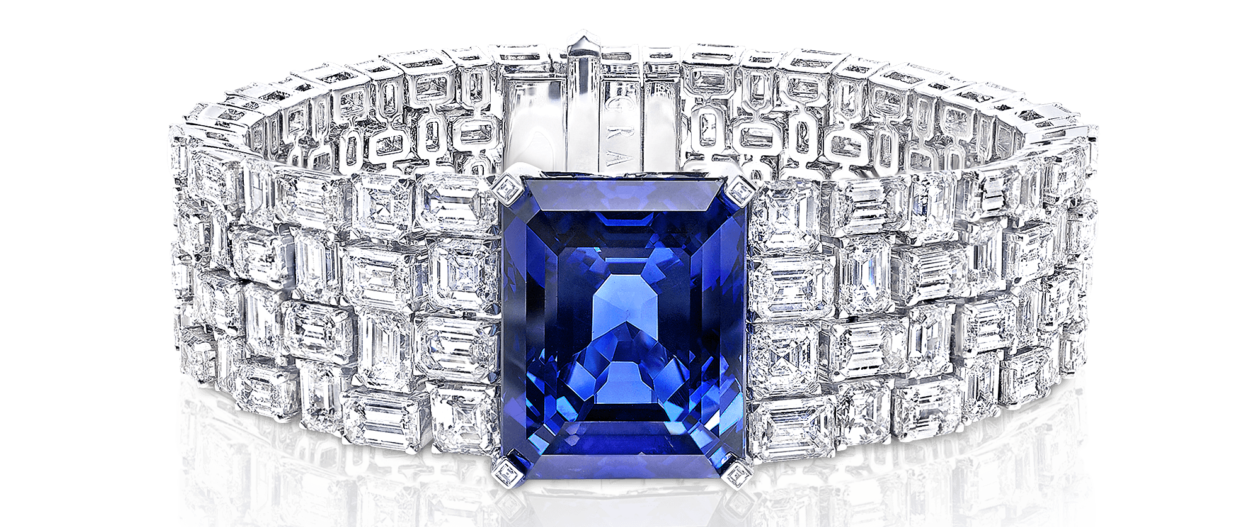
The parure is in the finest Directoire style. It was probably designed in its current form in Vienna in 1809/10, and some parts were also recreated at that time.
However, parts of it probably date back to the late 18th century and were reused.
The necklace clearly shows the style of 1770 and the three Florentine lilies (in their shape referring to the House of Habsburg-Tuscany) the taste of the time around 1795.
The relatively simple diadem originally had the three aforementioned lilies between its four drops, which were only recently transformed into individual – and more usable – brooches; Empress Marie-Louise still wore them on the diadem.
Tiara:
The gold-set diamond headband features a double band of diamonds, topped by five rosettes, each with an oval sapphire surrounded by diamonds. Between these rosettes, there is an openwork S-shaped motif. Above the headband, a six-pronged band of diamonds, four points terminating in large, pear-shaped sapphires. (80,000 Swiss francs)
Necklace
: A simple necklace with ten rectangular-oval sapphires suspended between rosettes of five brilliant-cut diamonds each, featuring a rich floral motif of branches and ribbons. Within these rosettes, and on the other, pendants, nine large, rectangular sapphires and seven small sapphires surrounded by brilliant-cut diamonds. The entire necklace is densely set with brilliant-cut diamonds and rose-cut diamonds. (SFR 250,000)
Bracelet:
Openwork band of 16 lily-shaped motifs set with diamonds, on which eight large, rectangular sapphires are mounted at regular intervals. (SFR 45,000)
Tiara Centerpiece Brooch
This brooch was originally the centerpiece of the tiara. It is shaped like a large Florentine love, densely studded with brilliant-cut diamonds and rose-cut diamonds, with a large rectangular sapphire as the band. (SFR 35,000)
Two brooches – tiara pieces
. Originally the side pieces of the tiara. Shaped like lilies, some set with large diamonds, each with a large rectangular sapphire as a band. (CHF 40,000)
Source: Stucker Auction starting price: €450,000.
The listed estimate primarily takes into account the material of the individual pieces; beyond that, the jewels naturally possessed the value of stylish antiques and, above all, the inestimable value of highly significant historical pieces. December 3, 1964
Sapphire Parure of the Marie-Louise Empress of France
When Marie Louise von Habsburg (12 Dec 1791 – 17 Dec 1847), daughter of Emperor Francis I of Austria married the Emperor Napoleon I on 2 April 1810, she brought in her rich dowry a number of significant and invaluable pieces of jewellery to Paris.
Among these pieces was a sapphire parure of exquisite beauty, assembled from 46 light blue sapphires of the same tint and of graduated size set in hundreds of fine quality diamonds. This parure was the wedding gift from the Emperor to his daughter, whose marriage to Napoleon ushered a brief peace between Austria and France. Marie Louise wore the jewellery on several occasions, as shown in the image above.
After the collapse of the Napoleonic Empire, the jewels, which were the private property of the ex-Empress, returned with her to Vienna. The jewels remained in her possession during her reign as Duchess of Parma (1816-1847) and after her death returned to the private treasury of the Austrian Emperor.
Emperor Franz Joseph later lent the jewels in 1860 his brother. The last owner was the Duchess of Lorraine. A grand-niece of the old emperor, the Duchess is seen in the photo above wearing the jewellery. With the partial occupation of Austria by the Russians in 1945, the jewels were taken hurriedly to safety causing the hitherto existing original cases, bearing the imperial arms, to be lost.
Precious Blue and White Bow genuine 22.9 carat Sapphire .925 Sterling Silver handcrafted Necklace

















